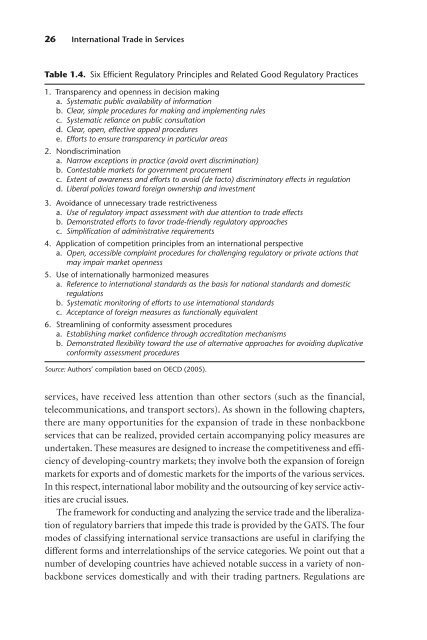International Trade in Services.pdf - DSpace at Khazar University
International Trade in Services.pdf - DSpace at Khazar University
International Trade in Services.pdf - DSpace at Khazar University
You also want an ePaper? Increase the reach of your titles
YUMPU automatically turns print PDFs into web optimized ePapers that Google loves.
26 <strong>Intern<strong>at</strong>ional</strong> <strong>Trade</strong> <strong>in</strong> <strong>Services</strong><br />
Table 1.4. Six Efficient Regul<strong>at</strong>ory Pr<strong>in</strong>ciples and Rel<strong>at</strong>ed Good Regul<strong>at</strong>ory Practices<br />
1. Transparency and openness <strong>in</strong> decision mak<strong>in</strong>g<br />
a. System<strong>at</strong>ic public availability of <strong>in</strong>form<strong>at</strong>ion<br />
b. Clear, simple procedures for mak<strong>in</strong>g and implement<strong>in</strong>g rules<br />
c. System<strong>at</strong>ic reliance on public consult<strong>at</strong>ion<br />
d. Clear, open, effective appeal procedures<br />
e. Efforts to ensure transparency <strong>in</strong> particular areas<br />
2. Nondiscrim<strong>in</strong><strong>at</strong>ion<br />
a. Narrow exceptions <strong>in</strong> practice (avoid overt discrim<strong>in</strong><strong>at</strong>ion)<br />
b. Contestable markets for government procurement<br />
c. Extent of awareness and efforts to avoid (de facto) discrim<strong>in</strong><strong>at</strong>ory effects <strong>in</strong> regul<strong>at</strong>ion<br />
d. Liberal policies toward foreign ownership and <strong>in</strong>vestment<br />
3. Avoidance of unnecessary trade restrictiveness<br />
a. Use of regul<strong>at</strong>ory impact assessment with due <strong>at</strong>tention to trade effects<br />
b. Demonstr<strong>at</strong>ed efforts to favor trade-friendly regul<strong>at</strong>ory approaches<br />
c. Simplific<strong>at</strong>ion of adm<strong>in</strong>istr<strong>at</strong>ive requirements<br />
4. Applic<strong>at</strong>ion of competition pr<strong>in</strong>ciples from an <strong>in</strong>tern<strong>at</strong>ional perspective<br />
a. Open, accessible compla<strong>in</strong>t procedures for challeng<strong>in</strong>g regul<strong>at</strong>ory or priv<strong>at</strong>e actions th<strong>at</strong><br />
may impair market openness<br />
5. Use of <strong>in</strong>tern<strong>at</strong>ionally harmonized measures<br />
a. Reference to <strong>in</strong>tern<strong>at</strong>ional standards as the basis for n<strong>at</strong>ional standards and domestic<br />
regul<strong>at</strong>ions<br />
b. System<strong>at</strong>ic monitor<strong>in</strong>g of efforts to use <strong>in</strong>tern<strong>at</strong>ional standards<br />
c. Acceptance of foreign measures as functionally equivalent<br />
6. Streaml<strong>in</strong><strong>in</strong>g of conformity assessment procedures<br />
a. Establish<strong>in</strong>g market confidence through accredit<strong>at</strong>ion mechanisms<br />
b. Demonstr<strong>at</strong>ed flexibility toward the use of altern<strong>at</strong>ive approaches for avoid<strong>in</strong>g duplic<strong>at</strong>ive<br />
conformity assessment procedures<br />
Source: Authors’ compil<strong>at</strong>ion based on OECD (2005).<br />
services, have received less <strong>at</strong>tention than other sectors (such as the f<strong>in</strong>ancial,<br />
telecommunic<strong>at</strong>ions, and transport sectors). As shown <strong>in</strong> the follow<strong>in</strong>g chapters,<br />
there are many opportunities for the expansion of trade <strong>in</strong> these nonbackbone<br />
services th<strong>at</strong> can be realized, provided certa<strong>in</strong> accompany<strong>in</strong>g policy measures are<br />
undertaken. These measures are designed to <strong>in</strong>crease the competitiveness and efficiency<br />
of develop<strong>in</strong>g-country markets; they <strong>in</strong>volve both the expansion of foreign<br />
markets for exports and of domestic markets for the imports of the various services.<br />
In this respect, <strong>in</strong>tern<strong>at</strong>ional labor mobility and the outsourc<strong>in</strong>g of key service activities<br />
are crucial issues.<br />
The framework for conduct<strong>in</strong>g and analyz<strong>in</strong>g the service trade and the liberaliz<strong>at</strong>ion<br />
of regul<strong>at</strong>ory barriers th<strong>at</strong> impede this trade is provided by the GATS. The four<br />
modes of classify<strong>in</strong>g <strong>in</strong>tern<strong>at</strong>ional service transactions are useful <strong>in</strong> clarify<strong>in</strong>g the<br />
different forms and <strong>in</strong>terrel<strong>at</strong>ionships of the service c<strong>at</strong>egories. We po<strong>in</strong>t out th<strong>at</strong> a<br />
number of develop<strong>in</strong>g countries have achieved notable success <strong>in</strong> a variety of nonbackbone<br />
services domestically and with their trad<strong>in</strong>g partners. Regul<strong>at</strong>ions are

















